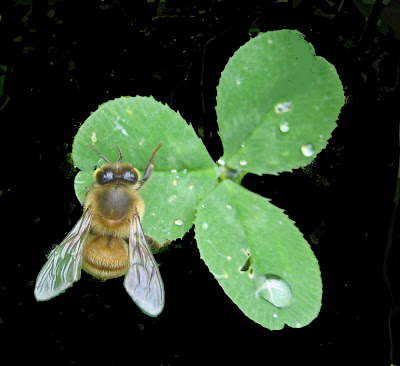
No, it's not a posthumously published
Edward Gorey story, but a ubiquitous scoundrel of a plant named burdock. You may recall that in the recent
Got Milkweed? post, we explored the risky nature of pollinating that flower—talk about unsafe sex!
Well, burdock puts milkweed to shame when it comes to pathological tendencies. Three years ago, an innocent looking burdock blossom savagely murdered a beautiful young hummingbird at the edge of my garden and earned my eternal wrath. Since then, I've done all I can to eradicate it with a scythe. It's great exercise!
It's also a Sisyphean undertaking. My bemused neighbors occasionally catch me in the act and shake their heads. "You'll
never get rid of that stuff," they say, unaware that I've got a vendetta to fulfill and more than enough Italian in my blood to make good on it. However, as one who at least
aspires to mental hygiene, I ritualistically transform the bitter herb of revenge into the sweet heirloom tomato of environmental correctness by building mountain-high compost piles out of the burdock's elephantine leaves and massive stems. Again—good exercise!
The irony is that burdock would be a great weed to have around if it didn't have such murderous tendencies. The roots are
edible (I've had some wonderful Japanese preparations and I know it's popular in old-world Italian cooking). The flowers are a pretty purple. And come to find out, the honeybees and bumblebees really like it. So what's not to like?
The problem lies in the tiny, Velcro-like barbs that surround the base of the flower. (In fact, the man who invented Velcro reported having gotten the idea from observing these, or similar, plants.)
Although most pollinators seem to make their visits to the flowers without incident, plenty don't. Between the horrifying hummer incident and a bird skeleton I found stuck to the dried flowers one winter, I am
so over this plant!

As if the above-mentioned incidents weren't enough, the other morning, I found a bat struggling to get free from a burdock flower. I ran home, threw on my beek suit and gloves, got my "surgical equipment" and freed it, but its wings had been torn and I believe it perished after I left it, still clinging upside-down to the burdock stem—one of the most forlorn sights I've come upon in a long time.

Afterwards, in the interest of further building my case against this pernicious plant, I conducted a brief census of a patch of burdock and found 2 stuck honeybees—one practically mummified, the other still alive but beyond assistance.


I assume the evolutionary excuse for this barbed structure is dispersal. The idea would be that the dried, seed-rich flower adheres (temporarily) to the leg of a deer, say, and is transported to another area, thereby extending its range. Just so we know it's not being mean for the hell of it.
The thing is, it's a pretty good-looking plant and it clearly appeals to the local pollinators. So let's for a moment simply enjoy these images of burdock at its best.
 A bee's-eye view.
A bee's-eye view.  Inviting-looking pollen available to all who chose to provide pollination services herein—but watch those barbs!
Inviting-looking pollen available to all who chose to provide pollination services herein—but watch those barbs! An old girl (note tattered wings) with pollen-dusted head.
An old girl (note tattered wings) with pollen-dusted head. Coming in for a landing....
Coming in for a landing....  A lovely bumblebee virtually saturated in fairy dust.
A lovely bumblebee virtually saturated in fairy dust.The great chronicler of honeybee life, Maurice Maeterlinck, spoke eloquently of the sadness we often find alongside nature's beauty, abundance, and joy.
"...all things in nature are sad, when our eyes rest too closely upon them....At the present hour the duty before us is to seek out that which perhaps may be hiding, behind these sorrows; and, urged on by this endeavor, we must not turn our eyes away, but steadily, fixedly, watch these sorrows and study them, with a courage and interest as keen as though they were joys. It is right that before we judge nature, before we complain, we should at least ask every question that we can possibly ask."
Words to live by...with scythe firmly in hand.
 They say bee stings are more painful in the fall, and without having the slightest ideas why that might be, I'm beginning to think it's true. Got a couple of stings on my hand while checking the very crowded Green Hive the other day and couldn't believe how different these stings felt from those received earlier in the summer.
They say bee stings are more painful in the fall, and without having the slightest ideas why that might be, I'm beginning to think it's true. Got a couple of stings on my hand while checking the very crowded Green Hive the other day and couldn't believe how different these stings felt from those received earlier in the summer.
















































